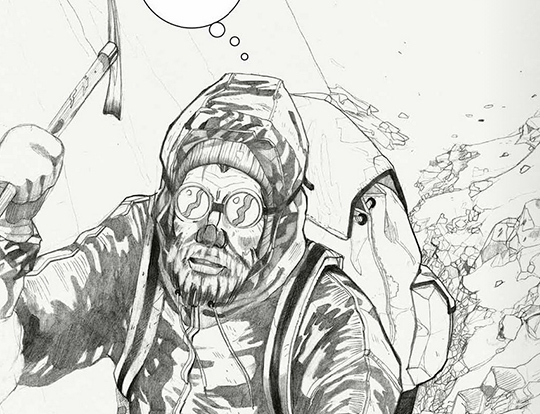
The mountains are silent teachers, and they teach us noble qualities: humility in the face of nature, modesty, courage, privation, and strength of will.–Hermann Buhl
His eyes framed by weathered lines and thick haystack hair that sprouted from behind cockeyed glacier goggles, Hermann Buhl was a man obsessed. Reflected in the glass of his goggles were the slopes of 8126-meter Nanga Parbat, a peak whose summit had never been attained by man, and whose flanks had already claimed 31 lives. He had been climbing so long he had stopped thinking. “I walked and walked, climbed and climbed, for hours and hours,” he wrote in The Lonely Challenge. “My earlier climbs had taught me not to give in before I got to the top; and I had never given up….But this was quite different; now it was an incredible irresistible urge that drove my exhausted body onward.”
For many, he represented the consummate alpinist of the 1950s. The first man to claim two first ascents on 8000-meter peaks, his climbs were among the most daring of his time and remain impressive feats of alpinism to this day. Horst Hofler, co-author of Hermann Buhl: Climbing Without Compromise, wrote of Buhl, “[He] was obsessed with climbing. He had…hardly any other interest and he wanted nothing other than to improve his extreme climbing.” But as a child Buhl was told to stay home, that he didn’t belong in the mountains.
Although Buhl knew his own physical weaknesses, describing his adolescent self in Nanga Parbat Pilgrimage as “a half-grown boy, whose frail build made an impression diametrically opposed to that of the popular conception of a hero,” he was determined. “‘Me not belong in the Mountains?’ Why, I couldn’t go on living without them! My thoughts, my dreams, my whole life were nothing but the Mountains!” By 1953, at the age of 29, the once-feeble Buhl became the first man to stand on the summit of Nanga Parbat, which was, at the time, the second highest peak ever climbed.
During a time when siege tactics were common, and fast and light climbs were nearly unheard of, Buhl reached Nanga Parbat’s summit alone and without oxygen in a 41-hour roundtrip push, having spent a night in a standing bivy about 150 meters below the summit. He would go on to complete the first ascent of 8051-meter Broad Peak in 1957 without oxygen or high-altitude porters. “Buhl, tired and drained, hampered by his previously frostbitten foot…makes it to the top only by virtue of his undiminished strength of will,” Hofler writes. The climb was groundbreaking.
“Buhl was decades ahead of his time,” Reinhold Messner writes in Climbing Without Compromise. “Had Hermann Buhl been born forty years later he would surely have been one of the leading sport climbers, and a classic mountaineer without equal.” Alas, Buhl’s time was cut short when he fell through a cornice on Chogolisa, shortly after his Broad Peak ascent. “When Buhl was declared missing I cried, too,” Messner wrote.
In tribute to Buhl, Jerzy Porebski and artist Ewa Labaj have created this comic about his life as an alpinist.
[For another Porebski-Labaj collaboration, see The Lho La Tragedy: Beginning of the End about the 1989 avalanche disaster on the West Ridge of Everest.–Ed.]